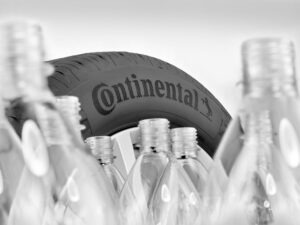
Sustainable materials in tire production include plastic bottles
Canadian Plastics
Automotive Recycling SustainabilityContinental Tire is aiming for fully circular operations in its tire production by 2050.

Photo Credit: Continental Tire
Germany-based tire maker Continental Tires has announced a plan for all of its tires to be made of sustainable materials – including recycled PET bottles – by 2050.
“There is still a long way to go [but] step by step, it is already becoming apparent which raw materials will find their way into tire construction in the future,” Continental officials said in a Feb. 14 news release. “These include waste products from agriculture – such as the ash from rice husks – rubber from dandelions, recycled rubber or PET bottles.”
Around 15 to 20 per cent renewable or recycled materials are used in a standard passenger car tire from Continental currently. Continental analyzes and reviews all raw materials used in tire production to increase the proportion of sustainable materials and conserve valuable resources.
Depending on the application, season, and environment, tires must fulfill specific requirements. These elements can be seen in, for example, the tread design. But in other areas – the composition of the rubber compound, for example – these changes are not so readily visible. Passenger car tires from Continental consist of as many as a hundred different raw materials.
“Natural rubber is essential for ensuring outstanding tire performance,” Continental said. “This natural product accounts for between 10 and 40 per cent of the entire weight of modern high-performance tires. Its unique properties include a high level of strength and durability, which are caused by the strain-induced crystallization of the rubber.” With its Taraxagum project, Continental is pursuing an approach to ensure that it can become less dependent on natural rubber grown primarily in Southeast Asia. The tire manufacturer is working alongside partners on industrializing the extraction of natural rubber from specially cultivated dandelion plants.
At the latest, Continental is aiming for fully circular operations in its tire production by 2050. In addition to using renewable materials, the company is working on using recycled raw materials in tire production. This process is intended to ensure that carbon black – another crucial filler in rubber compounds – can be obtained on a large scale. Continental recently signed a development agreement with Pyrum Innovations, intending further to optimize the recycling of materials from old tires. To do this, Pyrum breaks the old tires down into their constituent parts in an industrial furnace using a special pyrolysis process. In this way, valuable raw materials contained in end-of-life tires can be extracted and recycled. Both companies are working towards obtaining high-quality raw materials from the pyrolysis oil obtained for Continental’s tire production in the medium term, in addition to the direct use of high-quality carbon black. In the long term, the premium tire manufacturer and Pyrum are aiming to establish a closed-loop circular economy concept for recycling old tires.
In addition to pyrolysis, Continental uses mechanical processing of end-of-life tires. Rubber, steel and textile cord, in particular, are separated, in a highly sophisticated process, from one another. The rubber is then prepared for reuse as part of new rubber compounds.
Continental also works with partners to obtain high-quality polyester yarn for its tires from recycled PET bottles, which would otherwise end up in incinerators or landfills. With its ContiRe.Tex technology, Continental says it has developed a more energy-efficient and eco-friendly alternative that allows it to reuse between nine and fifteen plastic bottles for each tire, depending on the tire size. “Recycled PET has already replaced conventional polyester in the structures of some tire casings,” Continental said. “The PET bottles used are sourced exclusively from regions with no closed recycling loop.”
